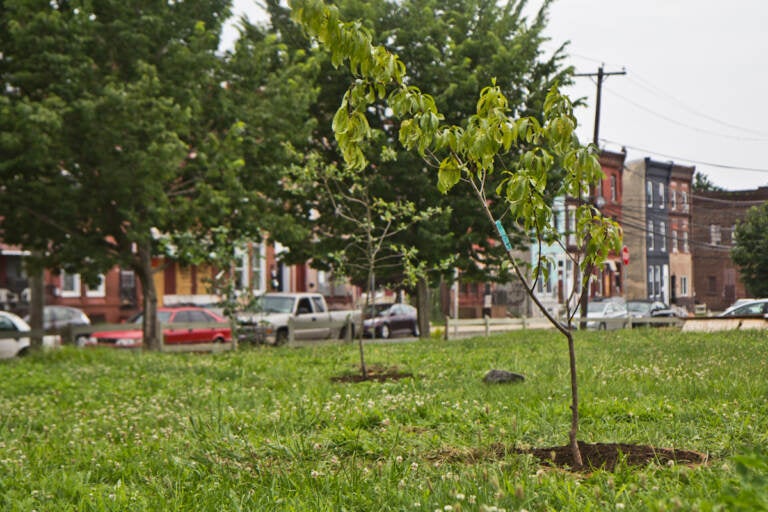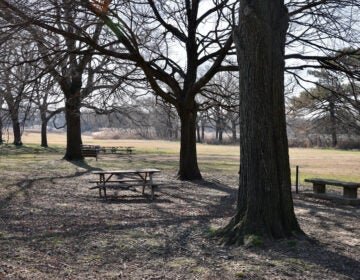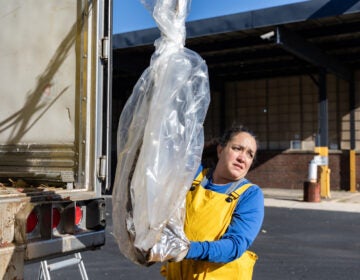Let the tree planting begin again: PHS is putting another 1,350 in the ground
Fall and spring are the best times to plant. Pennsylvania Horticultural Society is providing trees that are 10 to 15 feet tall, for immediate impact.

Nine fruit trees were planted on a lot on the 1900 block of Norris Street in North Philadelphia. (Kimberly Paynter/WHYY)
The Pennsylvania Horticultural Society is once again planting trees across the Philadelphia region, with the goals of developing much-needed tree canopy; promoting healthy, green communities; and building social connections. PHS, perhaps best known as producer of the annual Philadelphia Flower Show, will plant more than 1,350 trees with the help of its 80 Tree Tender groups, community organizations, and neighborhood volunteers.
“And they’ll all be planted between … Wednesday the 17th and the last one, I think, is going to go in the ground on Monday, which is the 22nd. So it’s basically five or six days of tree planting to get all these trees in the ground,” Tim Ifill, director of trees for PHS, told WHYY News.
Adding trees makes a positive impact in neighborhoods. Studies have linked increased tree canopy — the area shaded by trees — to lower rates of violence and better health outcomes, including reduction in heat-related illness. According to a U.S. Forest Service report, Assessment of Philadelphia’s 2025 Tree Canopy Cover Goals, “researchers estimate that achieving 30% tree canopy would prevent 400 premature deaths per year in Philadelphia. With this statistic in mind, the Greater Philadelphia region still needs more trees.”
Ifill said the trees PHS is planting are between 10 and 15 feet tall.
“You know, significantly sized trees, and a good chunk of them, probably the majority, are going to get planted as street trees. So they’ll make a difference right away. They’ll be good size and really noticeable and, you know, big enough to make an impact,” Ifill said. “Of course the real long-term impact happens over the course of decades as the trees reach their mature size. And again, that will vary depending on the species. Some of them will take many decades to reach full maturity, for a species like an oak, for instance, but they’ll make an impact right away.”
Why trees? As opposed to, say, shrubs that are easier to transport and plant?
“A street with a significant number of street trees or trees around it will be 4 to 10 degrees cooler than a street that doesn’t have trees planted. So that’s a real difference that only trees make because they can kind of spread those canopies. And between the shade and transpiration of water through the leaves will create a cooler microclimate where they’re planted,” he said.
Planting trees cleans the air as well, Ifill said.
“They store so much carbon, which is obviously really important for global warming as well, which shrubs can do to improve air quality, certainly, but not nearly as much as trees — and that’s really a factor of the cumulative surface area of all of the leaves. That’s where all that work is happening, and there’s just no way a shrub can compete with a tree for that,” Ifill said. “They also provide mental health benefits, as shrubs and other plants [do] too. And other types of greenery do as well, but you know there’s measurable mental health improvements and physical health improvements that have been shown in areas with a lot of trees.
“As climate change hits us and as we kind of are facing that reality, we can make our neighborhoods more livable and more comfortable in the face of those climate changes that are happening right now. So that’s a big part. of it,” he said.
Stormwater management is another big benefit of trees, Ifill noted.
“They intercept rainwater, and then the roots take up a lot of stormwater that would otherwise overwhelm our infrastructure for that.”
To decide which parts of the city in which to plant, PHS has a tree-priority map it developed in partnership with Philadelphia’s Department of Parks and Recreation.
“And we use not just existing canopy data, but we also use data of where canopy has declined. We used a lot of health data, income, average income level data for each neighborhood, crime data as well, and we created a formula to prioritize neighborhoods based on that,” Ifill said.
Last month, two other local nonprofits, Riverfront North Partnership and the Tookany/Tacony-Frankford Watershed Partnership, teamed up to plant 200 trees along Pennypack Creek in Northeast Philadelphia. The groups, working with the Arbor Day Foundation, also gave away 150 trees to residents of the city’s Holmesburg and Frankford neighborhoods. Their goal was to help reduce the amount of rainwater runoff that flows into the Delaware River and to add to the tree canopy in the two communities.
“Fall and spring are the two best times to plant, in terms of the health of the trees and the longevity of the trees, because they’re either just coming out of dormancy or just entering dormancy, which is a really good time for the tree, kind of reduces the stress on them,” Ifill said. “Those first two years that they’re in the ground are so critical. Because they’re really putting a lot of energy into building up and establishing their root system, which is a lot of work for a tree. And so making sure they’re really cared for, and minimizing the stress they face during that establishment period, is really important. And planting timing is a big element for that.”
The PHS Tree Tenders program provides workshops in tree planting and care. According to its website, the Horticultural Society has trained more than 5,000 people who have gone on to lead volunteers in planting over 2,000 trees each year.
Among sponsors of this week’s tree planting efforts are Aqua Pennsylvania, Bartlett Tree Experts, the HBE Foundation, Penn Treaty Special Services District, Pennsylvania’s Department of Conservation and Natural Resources and Department of Environmental Protection, the Pennsylvania Urban and Community Forestry Council, the Philadelphia Collaborative for Health Equity, the Philadelphia Division of Housing and Community Development, the Philadelphia Phillies, and Philadelphia Gas Works.

Get daily updates from WHYY News!
WHYY is your source for fact-based, in-depth journalism and information. As a nonprofit organization, we rely on financial support from readers like you. Please give today.





